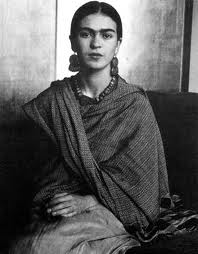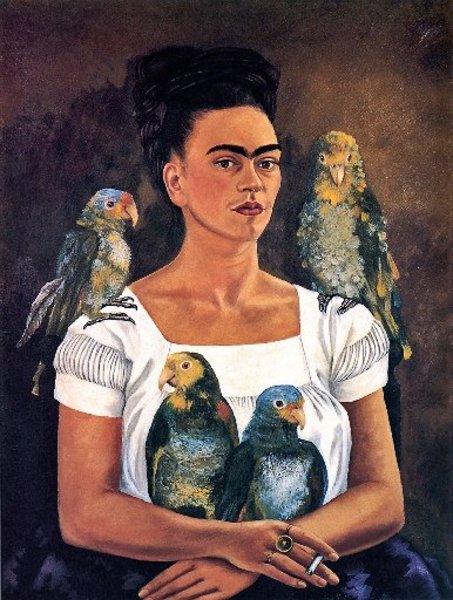 Everyone’s familiar with Frida Kahlo’s face, at least as she painted it. The dark, somber eyes. The brightly-colored dresses. That inescapable unibrow.
Everyone’s familiar with Frida Kahlo’s face, at least as she painted it. The dark, somber eyes. The brightly-colored dresses. That inescapable unibrow.
But Frida Kahlo is much more than that famous face, with its ugly beauty and its unconventional emphasis on female facial hair. She’s also a fascinating figure who lived through some of the early twentieth century’s most interesting events, who was attached to some of the early twentieth century’s most interesting people. And on top of that, she really put the “pain” in “awesome painter.” (Sorry. A stretch, I know.)
Frida was born in 1907 in Mexico City, just before the Mexican Revolution, to an immigrant Hungarian-Jewish father and a Spanish-Amerinidian mother. She suffered from polio at a young age, resulting in a permanently withered leg. But the seminal painful moment in Frida’s life was in 1925, when she was in a horrific bus accident that left her with spinal fractures, multiple broken bones, a crushed foot, and, the one that gives me the biggest heebie-jeebies, an impaling by a metal handrail. She wasn’t expected to survive.
But survive she did—albeit with an enormous amount of pain that never really left her. She went on to have over 30 surgeries in her lifetime, the last of which may have left her with the pneumonia that killed her at age 47 (though it’s also speculated she killed herself).
Despite the immense pain that was to haunt her and characterize her relationship with her body—or maybe, in part, because of it—Kahlo went on to do great things. She began painting while in bed, recovering from the bus accident, starting with her most famous subject: herself. “I paint myself because I am so often alone,” she said, “because I am the subject I know best.”
At age 22 she married famed muralist Diego Rivera, who was two decades older and two hundred pounds heavier than her (!). Their relationship helped her to develop her own work, while also being one of those Hollywood-style tumultuous marriages with tons of affairs on both sides and even a divorce thrown in the middle (after which they remarried, each other). Frida, for her part, had affairs with many famous figures, both men and women, including Georgia O’Keeffe and Leon Trotsky, whom she and Rivera put up in their home after his flight from Russia. (Ironically, after he was assassinated she became a Stalinist.)
Meanwhile, Kahlo’s work was feted in New York City and Paris, and she was the first 20th-century Mexican artist to be featured in the Louvre. I can just imagine her mingling in that most romantic of settings, 1920s Paris (think Midnight in Paris), at an art showing, being toasted by Picasso and Miró and Andre Breton, a Parisian anomaly in her long, bright, traditional Mexican dress.
But as it were, Frida rejected what she called those “artistic bitches of Paris.” Her heart remained in Mexico City, where she lived most of her life in La Casa Azul, the house she was born in (which today houses Museo Frida Kahlo-- a must on my world tour list!). She and Rivera were also involved in a movement called Mexicanidad, aimed at preserving an essential, traditional Mexican culture in opposition to the encroaching cultural dominance of “the West.”
Kahlo attempted to live this Mexican ideal in her dress, in the symbols and colors of her art, and, also, in her rejection of conventional beauty norms. In fact, it’s reported she even darkened her unibrow and mustache to emphasize a kind of pre-Columbian femininity— where in this case, pre-Columbian means “before tweezers.”
Because of this, Frida Kahlo remains to this day a shining symbol of feminism and Mexican culture, and her art and celebrity have been completely embraced by the mainstream. But it’s easy to overlook the ways in which Kahlo’s art, and life, were less about empowerment and more about suffering, about the visceral experience of bodily pain and the social and political difficulties of being a woman. One of her most affecting works, My Birth, was painted after her miscarriage, depicting a bloodied Kahlo-like head emerging from a woman’s body.
Additionally, it should be recognized that "authenticity" movements seek an essentialized, pre-modern, sometimes imaginary past; in this case, a pre-Europe Mexico. Kahlo's embracing of "authentic" Mexican culture must be understood as a kind of political statement, rather than a representation of the Mexico that actually surrounded her.
In my opinion, the complexity of her personal and political life and the tragedy of her experiences, as well as the diverse vitality of her influences—which range from street artists to Catholic votive paintings to images of disasters to pre-Columbian folk art—makes her work all the more fascinating. There's so much beauty in what she created. Beauty in the attempts at authenticity; beauty in the expressions of human suffering; and, perhaps most surprisingly, beauty in the ugliness. I'm not going to grow a unibrow out in solidarity, but doesn't mean I don't appreciate what that unibrow represented.


